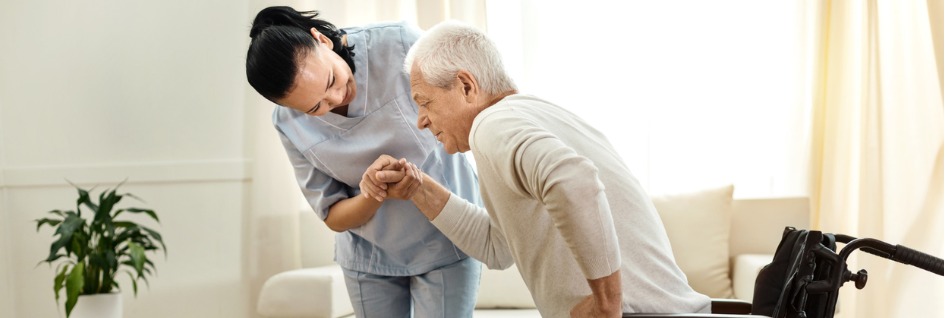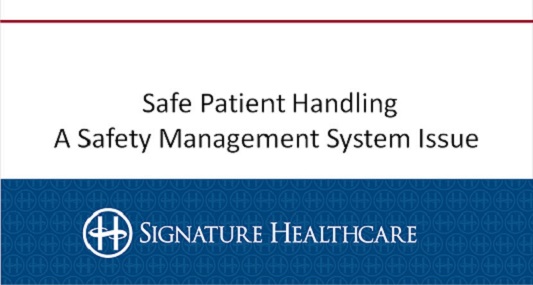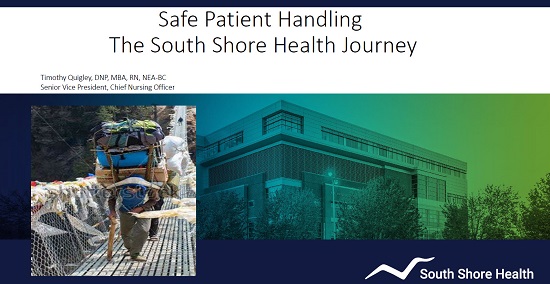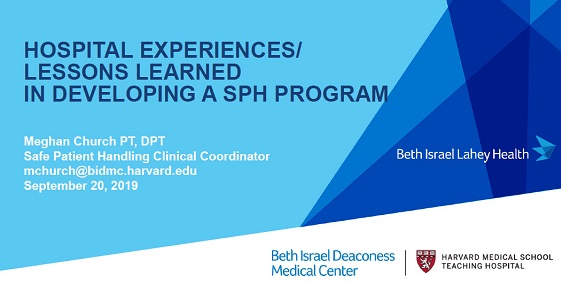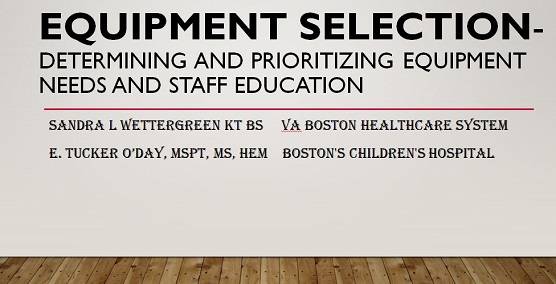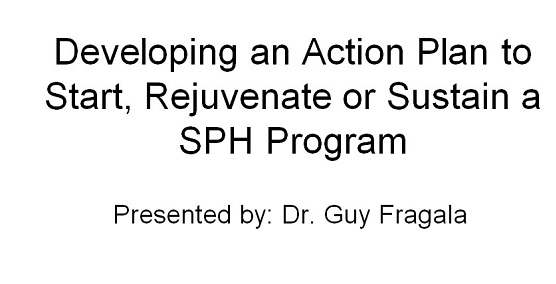Overview:
One major source of injury to healthcare workers is musculoskeletal disorders (MSDs). In 2017, nursing assistants had the second highest number of cases of MSDs. There were 18,090 days away from work cases, which equates to an incidence rate (IR) of 166.3 per 10,000 workers, more than five times the average for all industries. This compares to the all-worker days-away from work rate of 30.5 per 10,000 workers.
These injuries are due in large part to overexertion related to repeated manual patient handling activities, often involving heavy manual lifting associated with transferring, and repositioning patients and working in extremely awkward postures. Some examples of patient handling tasks that may be identified as high-risk include: transferring from toilet to chair, transferring from chair to bed, transferring from bathtub to chair, repositioning from side to side in bed, lifting a patient in bed, repositioning a patient in chair, or making a bed with a patient in it.
Sprains and strains are the most often reported nature of injuries, and the shoulders and low back are the most affected body parts. The problem of lifting patients is compounded by the increasing weight of patients to be lifted due to the obesity epidemic in the United States and the rapidly increasing number of older people who require assistance with the activities of daily living.
The consequences of work-related musculoskeletal injuries among nurses are substantial. Along with higher employer costs due to medical expenses, disability compensation, and litigation, nurse injuries also are costly in terms of chronic pain and functional disability, absenteeism, and turnover. As many as 20% of nurses who leave direct patient care positions do so because of risks associated with the work. Direct and indirect costs associated with only back injuries in the healthcare industry are estimated to be $20 billion annually. In addition, healthcare employees, who experience pain and fatigue, may be less productive, less attentive, more susceptible to further injury, and may be more likely to affect the health and safety of others.
Pathways to Safe Patient Handling in the Modern Hospital Setting Program
On September 20, 2019 the Massachusetts Health & Hospital Association in conjunction with the Massachusetts Department of Public Health and the Massachusetts Nurses Association hosted the Pathways to Safe Patient Handling in the Modern Hospital Setting Program.
The conference examined the importance of engaging hospital leadership, operational best practices, the skills that practitioners/staff need to sustain a safe patient handling program, and how to evaluate lessons learned. The program will also provide a forum to foster networking among attendees so that ongoing relationships and learning between hospitals can continue.
The Agenda and Presentations are listed below:
Session 1: Making the Business Case
Why is This Critical to Hospital Operations?
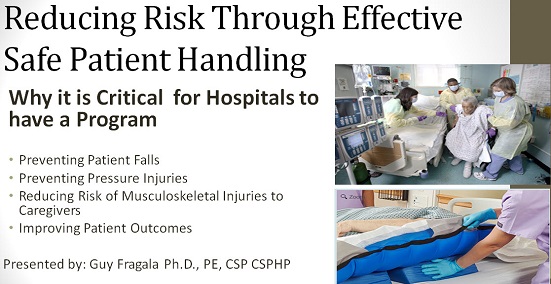
Reducing Risk Through Effective Safe Patient Handling - Why it is Critical for Hospital to have a Program
- Preventing Patient Falls
- Preventing Pressure Injuries
- Reducing Risk of Musculoskeletal Injuries to Caregivers
- Improving Patient Outcomes
Presented by: Guy Fragala Ph.D., PE, CSP CSPHP
Massachusetts Acute Care Hospital Experience
Safe Patient Handling - A Safety Management System Issue
Phases of Improvement
- Awareness
- Equipment and Training
- Compliance
Presented by: Kim Hollon, FACHE, President/CEO, Signature Healthcare
Patient Handling - The South Shore Health Journey
A Process Without End…
- 2004 – University of Lowell Ergonomic Assessment
- 2004 - First ceiling lift installed in ICU
- 2005 - Safe patient handling Task Force created
- 2006 - Roller boards adopted house wide
- 2014 - 50th ceiling lift installed/1st Bariatric room
- 2016 - Zoom stretchers for Birthing Unit
- 2017 - 75th ceiling lift /10th EMS Power stretcher
- 2018 - Hovermats introduced/6th Bariatric room
- 2019 - Standard work created for extraction of Emergency patients from cars
Presented by: Timothy Quigley, DNP, MBA, RN, NEA-BC, Senior Vice President, Chief Nursing Officer
Session 2: Essential Components of a Comprehensive SPH Program
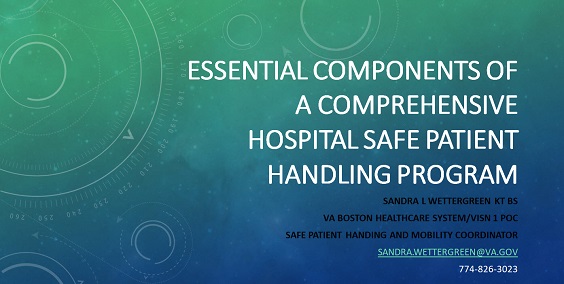
Key Elements of Safe Patient Handling for Hospitals
Objectives:
- Develop understanding of key essential components of a comprehensive hospital Safe Patient Handling and Mobility Program (SPHM).
- Understanding of phases for implementation of SPHM Program using key elements.
- Having key stakeholders on board with the program within the hospital to improve program implementation and success
Presented by: Sandra L Wettergreen KT BS, Safe Patient Handing and Mobility Coordinator, VA Boston Healthcare System/VISN 1 POC
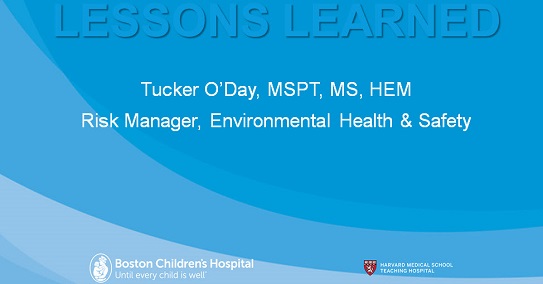
Lessons Learned
Overview:
- Executive Sponsor
- Identify Complementary Internal Initiatives
- Training/Education
- Direct Care Staff
- Housekeeping/Environmental Services
- Physicians
- Patients, Visitors, Family Members
- Support Systems
- Additional Thoughts
Presented by: Tucker O’Day, MSPT, MS, HEM, Risk Manager, Environmental Health & Safety, Boston Children's Hospital
Hospital Experiences/Lessons Learned in Developing a SPH Program
Purchasing equipment is just the beginning…
Presented by: Meghan Church PT, DPT, Safe Patient Handling Clinical Coordinator, Beth Israel Deaconess Medical Center
Session 3: Break Out Sessions: Operationalizing Elements of a SPH Program
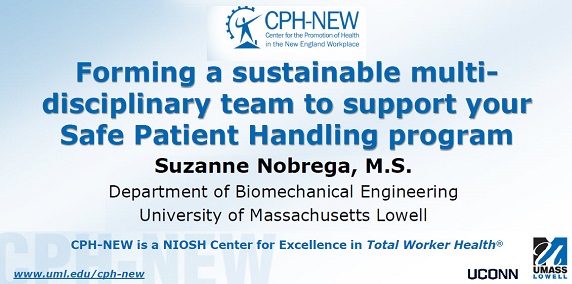
Forming a Sustainable Multi-Disciplinary Team to Support Your Safe Patient Handling Program
By the end of this session, you will be able to:
- Discuss roles for SPHM program team members related to the 10 essential elements of a SPHM Program
- Identify and recruit appropriate members to serve on a multidisciplinary SPHM program team
- Describe methods for involving caregiving staff when identifying and addressing barriers to safe patient handling
- Evaluate a hospital case study for organizing a multi-level, multi-disciplinary teams to address patient handling injuries
Presented by: Suzanne Nobrega, M.S., Department of Biomechanical Engineering, University of Massachusetts Lowell
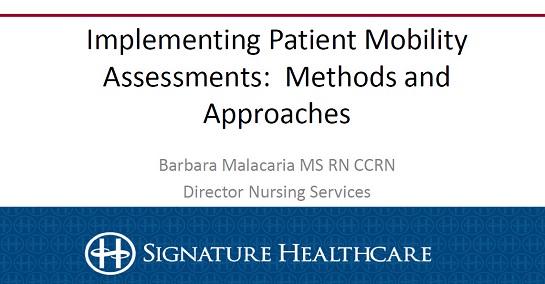
Implementing Patient Mobility Assessments: Methods and Approaches
Objectives:
- Identify 2 assessments of hospital readiness
- Identify 2 barriers to implementation
- Understand role of culture in implementation
- I have no financial disclosures
Presented by: Barbara Malacaria MS RN CCRN, Director Nursing Services, Signature Healthcare
Equipment Selection - Determining and Prioritizing Equipment Needs and Staff Education
Objectives:
- Understand how to conduct an assessment of SPHM needs
- Obtain injury data
- Identify high risk areas
- Determine types and amounts of equipment needed in all areas where lifting,transferring, repositioning and mobilizing occurs
- Recognize the types of equipment available for use in hospitals to decrease or eliminate manual mobilization
- Understand equipment planning considerations
- Learn how to address the mobility needs of special patient populations
Presented by: Sandra L Wettergreen KT BS VA Boston Healthcare System & E. Tucker O’day, MSPT, MS, HEM Boston Children’s Hospital
Session 4: Success and Sustainability
Developing an Action Plan to Start, Rejuvenate or Sustain a SPH Program
Reviewing and Sustaining a Program
- Involve staff from all levels throughout the organization
- Remember problems and solutions are multi-disciplinary
- Where to get started
- Think of a task force as opposed to a committee
Presented by: Guy Fragala Ph.D., PE, CSP CSPHP
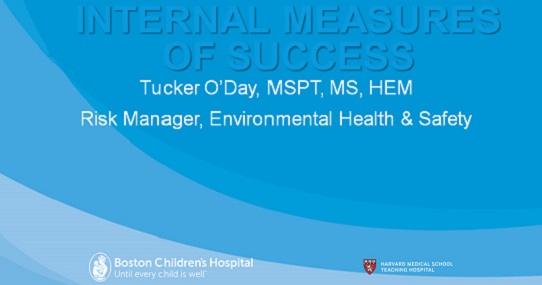
Internal Measures of Success
Overview:
- Patient Safety: Fall Trends and Pressure Injuries
- Training Participation
- Sling Laundering/Usage Tracking
- Training Evaluations
- Staff Feedback
- Success Stories
- Staff Surveys (Pre & Post)
- Occupational Incident & Injury Data
- Incidence of Preventable Patient Handling Events Retrospective Review of Calendar Years Q1/Q2
Presented by: Tucker O’Day, MSPT, MS, HEM, Risk Manager, Environmental Health & Safety, Boston Children's Hospital

